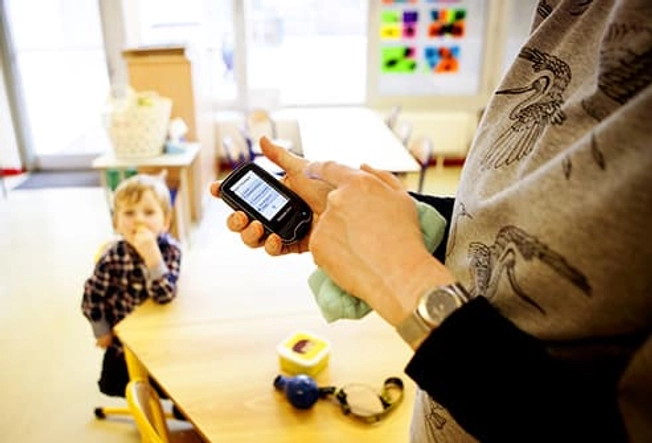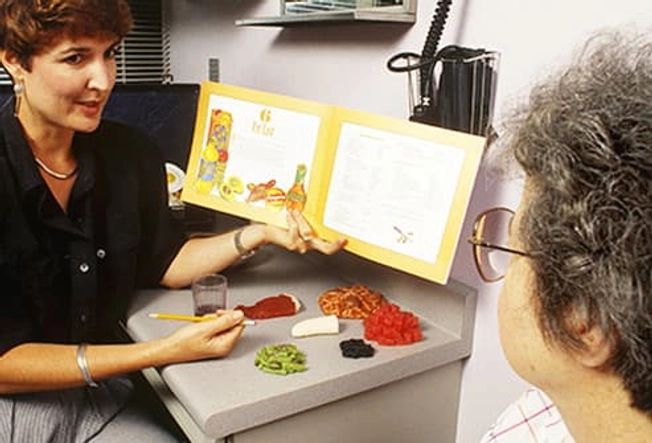- Overview & Types
- Symptoms & Diagnosis
- Treatment
- Living With
- Related Conditions
- Type 2 Diabetes
- Type 1 Diabetes
- Gestational Diabetes
- Appointment Prep
- View Full Guide
How to Manage Diabetes at Work


Plan for Success
Give yourself a smart start before your shift: Get plenty of sleep, don’t skip breakfast, and drink a glass of water before you head in. These simple self-care steps can lower your stress, which will keep blood sugar steady.

Bring Your Boss on Board
If it isn’t easy to take snack breaks on the job, or you don’t have a good spot to store your insulin, it’s time to tell your employer about your needs. Be ready to explain diabetes in simple terms, in case they doesn’t know much about it. Ask your doctor for helpful aids or a written note on your behalf.

Know Your Rights
If the thought of telling higher-ups about your diabetes makes you nervous, read up on your rights so you can go speak with confidence. The law is on your side when it comes to asking for small changes that help you manage your disease. The boss can’t punish you for it. In fact, they’re required by law to meet any reasonable request that helps you do your job.

Pick a Partner
You don’t have to tell everyone about your health, but it can help to share. At least one person should know where your supplies are, what the symptoms of low blood sugar look like, and how to get you help if you need it.

Fight Food Temptation
From birthday celebrations to morning doughnut runs to candy jars, the office can be a hotbed of hard-to-resist sweets. Prep yourself for carb cravings. Keep healthy snacks in your desk. If you do indulge, eat small portions and keep a close watch on your blood sugar levels.

Snack Smart
Plan for midafternoon sugar slumps. Fill a lunchbox with chopped veggies and hummus, keep protein bars on hand, or stash some healthy fats like almonds or walnuts near your workstation. You can also perk up with carb-free drinks like unsweetened iced tea or hot green tea.

Make Time to Move
If you work at a desk, find ways to build physical activity into your daily schedule. Set a timer to go off every 30 minutes, and take a short walk, even if it’s just up and down the hall. Do muscle stretches in your seat. Spend part of your lunch break walking up and down a staircase to get your heart rate up. Ask the boss about a standing or treadmill desk, if that’s an option at your office.

Expect Emergencies
Always have the tools on hand to treat a low-blood sugar event. Store them in your desk, keep a special bag nearby, or ask your employer for a place to stash your supplies. Add a note that explains how your gear works, in case you can’t give directions.

Know When to Test
Ask your doctor when you should test your blood sugar every day. It’s another good reason to get your employer up to speed: You may need to ask for a special time and space to do it.

Consider a CGM
A gadget called a continuous glucose monitor can check your blood sugar all day. A doctor sticks a tiny sensor under your skin. You carry the attached monitor in your pocket or wear it on a belt clip. It tests your sugar levels automatically and alerts you if they’re too high or low. This might be a good choice if you have a busy job that makes it hard to stop and test.

Be Schedule Savvy
Diabetes means you’ll have more doctor’s appointments on your calendar than many of your co-workers. When you can, get creative with your timing: Plan doctor visits near a holiday when workdays are slower. Ask for a slot on your way out of town for vacation, when you’re already scheduled to be out of the office.

Use Your Team
Keep your diabetes health care team in the loop so they can help troubleshoot workplace issues when they arise. Diabetes educators are a great resource for tricks and tips on the job to help you thrive.

Create Your Script
Whether you’re open about your diabetes or you want to keep it private, it can come up out of the blue and put you on the spot. Plan what to say ahead of time so you’ll feel more in control. Try something short and to the point: “I have type 1 diabetes. I have to watch what I eat and take medicine to control it.”

Keep Your Cool
No fridge at work for keeping your insulin at its proper temperature (36 to 46 F)? That's fine. To avoid a painful, cold injection, many diabetes educators suggest keeping insulin at room temperature while it's being used.
Insulin should last about one month at room temperature. You can keep insulin at work in a drawer with other diabetes supplies, if you wish.

Track Your Triggers
Do you struggle with your health during certain times of the year, month, or day? Do you travel for work? Does your job come with a stressful season? Talk to a doctor or diabetes educator about things that make it hard to take good care of yourself. They can help you figure out how to head off problems.